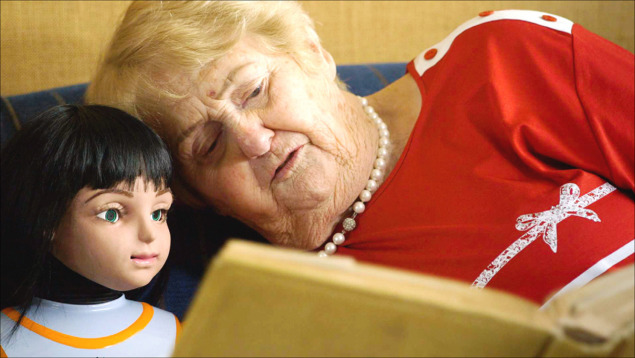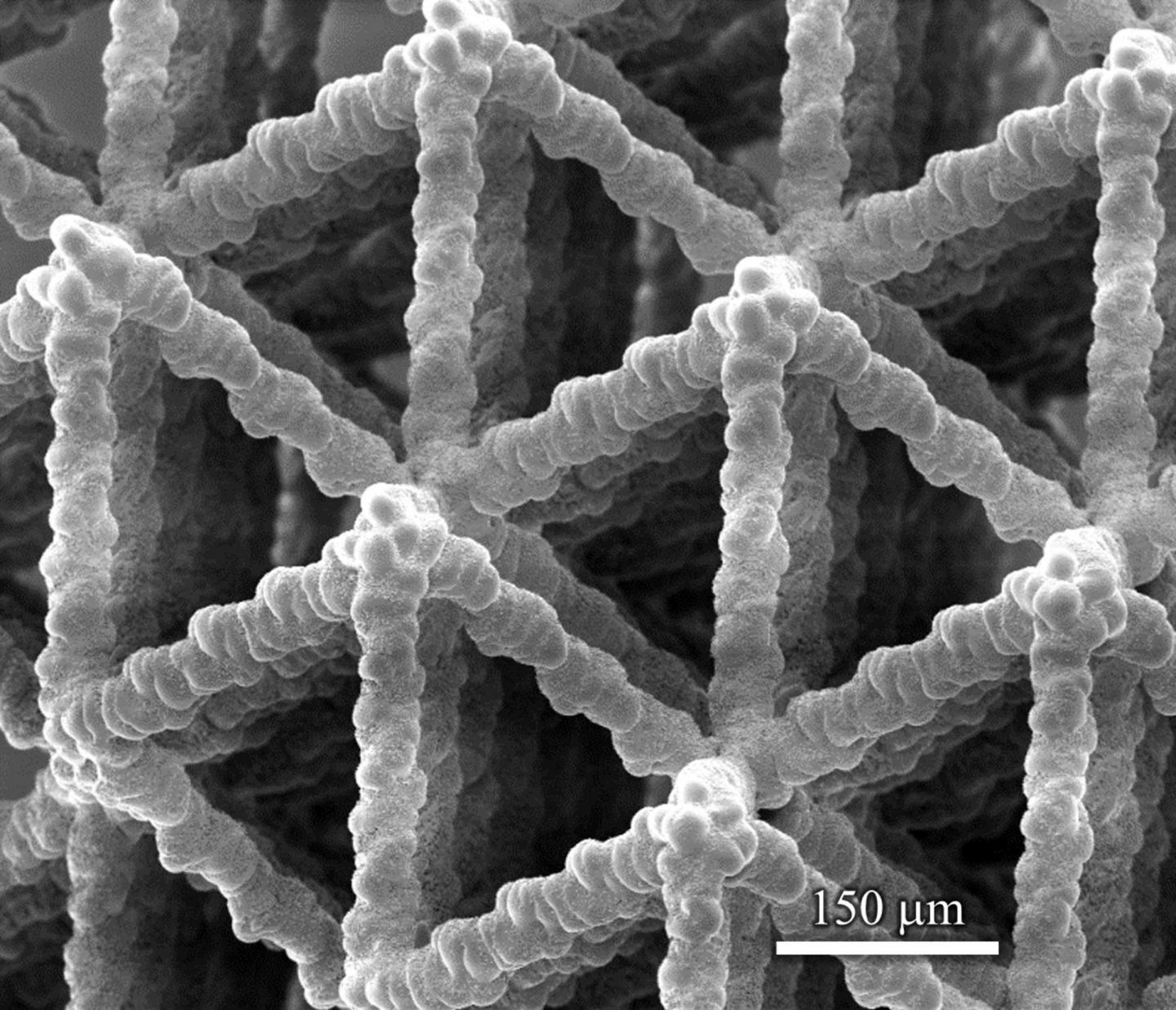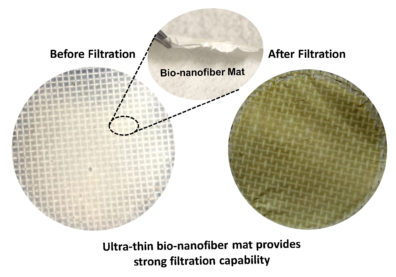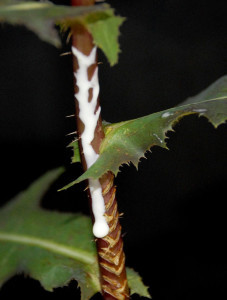I imagine that at some point the Washington State University’s (WSU) ‘elder care’ robot will be tested by senior citizens as opposed to the students described in a January 14, 2019 WSU news release (also on EurekAlert) by Will Ferguson,
A robot created by Washington State University scientists could help elderly people with dementia and other limitations live independently in their own homes.
The Robot Activity Support System, or RAS, uses sensors embedded in a WSU smart home to determine where its residents are, what they are doing and when they need assistance with daily activities.
It navigates through rooms and around obstacles to find people on its own, provides video instructions on how to do simple tasks and can even lead its owner to objects like their medication or a snack in the kitchen.
“RAS combines the convenience of a mobile robot with the activity detection technology of a WSU smart home to provide assistance in the moment, as the need for help is detected,” said Bryan Minor, a postdoctoral researcher in the WSU School of Electrical Engineering and Computer Science.
Minor works in the lab of Diane Cook, professor of electrical engineering and computer science and director of the WSU Center for Advanced Studies in Adaptive Systems.
For the last decade, Cook and Maureen Schmitter-Edgecombe, a WSU professor of psychology, have led CASAS researchers in the development of smart home technologies that could enable elderly adults with memory problems and other impairments to live independently.
Currently, an estimated 50 percent of adults over the age of 85 need assistance with every day activities such as preparing meals and taking medication and the annual cost for this assistance in the US is nearly $2 trillion.
With the number of adults over 85 expected to triple by 2050, Cook and Schmitter-Edgecombe hope that technologies like RAS and the WSU smart home will alleviate some of the financial strain on the healthcare system by making it easier for older adults to live alone.
“Upwards of 90 percent of older adults prefer to age in place as opposed to moving into a nursing home,” Cook said. “We want to make it so that instead of bringing in a caregiver or sending these people to a nursing home, we can use technology to help them live independently on their own.”
RAS is the first robot CASAS researchers have tried to incorporate into their smart home environment. They recently published a study in the journal Cognitive Systems Research that demonstrates how RAS could make life easier for older adults struggling to live independently
In the study CASAS researchers recruited 26 undergraduate and graduate students [emphasis mine] to complete three activities in a smart home with RAS as an assistant.
The activities were getting ready to walk the dog, taking medication with food and water and watering household plants.
When the smart home sensors detected a human failed to initiate or was struggling with one of the tasks, RAS received a message to help.
The robot then used its mapping and navigation camera, sensors and software to find the person and offer assistance.
The person could then indicate through a tablet interface that they wanted to see a video of the next step in the activity they were performing, a video of the entire activity or they could ask the robot to lead them to objects needed to complete the activity like the dog’s leash or a granola bar from the kitchen.
Afterwards the study participants were asked to rate the robot’s performance. Most of the participants rated RAS’ performance favorably and found the robot’s tablet interface to be easy to use. They also reported the next step video as being the most useful of the prompts.
“While we are still in an early stage of development, our initial results with RAS have been promising,” Minor said. “The next step in the research will be to test RAS’ performance with a group of older adults to get a better idea of what prompts, video reminders and other preferences they have regarding the robot.”
Here’s a link to and a citation for the paper,
Robot-enabled support of daily activities in smart home environment by Garrett Wilson, Christopher Pereyda, Nisha Raghunath, Gabriel de la Cruz, Shivam Goel, Sepehr Nesaei, Bryan Minor, Maureen Schmitter-Edgecombe, Matthew E.Taylor, Diane J.Cook. Cognitive Systems Research Volume 54, May 2019, Pages 258-272 DOI: https://doi.org/10.1016/j.cogsys.2018.10.032
This paper is behind a paywall.
Other ‘caring’ robots
Dutch filmmaker, Sander Burger, directed a documentary about ‘caredroids’ for seniors titled ‘Alice Cares’ or ‘Ik ben Alice’ in Dutch. It premiered at the 2015 Vancouver (Canada) International Film Festival and was featured in a January 22, 2015 article by Neil Young for the Hollywood Reporter,
The benign side of artificial intelligence enjoys a rare cinematic showcase in Sander Burger‘s Alice Cares (Ik ben Alice), a small-scale Dutch documentary that reinvents no wheels but proves as unassumingly delightful as its eponymous, diminutive “care-robot.” Touching lightly on social and technological themes that are increasingly relevant to nearly all industrialized societies, this quiet charmer bowed at Rotterdam ahead of its local release and deserves wider exposure via festivals and small-screen outlets.
… Developed by the US firm Hanson Robotics, “Alice”— has the stature and face of a girl of eight, but an adult female’s voice—is primarily intended to provide company for lonely seniors.
Burger shows Alice “visiting” the apartments of three octogenarian Dutch ladies, the contraption overcoming their hosts’ initial wariness and quickly forming chatty bonds. This prototype “care-droid” represents the technology at a relatively early stage, with Alice unable to move anything apart from her head, eyes (which incorporate tiny cameras) and mouth. Her body is made much more obviously robotic in appearance than the face, to minimize the chances of her interlocutors mistaking her for an actual human. Such design-touches are discussed by Alice’s programmer in meetings with social-workers, which Burger and his editor Manuel Rombley intersperses between the domestic exchanges that provide the bulk of the running-time.…
‘Alice’ was also featured in the Lancet’s (a general medical journal) July 18, 2015 article by Natalie Harrison,
“I’m going to ask you some questions about your life. Do you live independently? Are you lonely?” If you close your eyes and start listening to the film Alice Cares, you would think you were overhearing a routine conversation between an older woman and a health-care worker. It’s only when the woman, Martha Remkes, ends the conversation with “I don’t feel like having a robot in my home, I prefer a human being” that you realise something is amiss. In the Dutch documentary Alice Cares, Alice Robokind, a prototype caredroid developed in a laboratory in Amsterdam, is sent to live with three women who require care and company, with rather surprising results
Although the idea of health robots has been around for a couple of decades, research into the use of robots with older adults is a fairly new area. Alex Mihailidis, from the Intelligent Assistive Technology and Systems Lab [University of Toronto] in Toronto, ON, Canada, explains: “For carers, robots have been used as tools that can help to alleviate burden typically associated with providing continuous care”. He adds that “as robots become more viable and are able to perform common physical tasks, they can be very valuable in helping caregivers complete common tasks such as moving a person in and out of bed”. Although Japan and Korea are regarded as the world leaders in this research, the European Union and the USA are also making progress. At the Edinburgh Centre for Robotics, for example, researchers are working to develop more complex sensor and navigation technology for robots that work alongside people and on assisted living prosthetics technologies. This research is part of a collaboration between the University of Edinburgh and Heriot-Watt University that was awarded £6 million in funding as part of a wider £85 million investment into industrial technology in the UK Government’s Eight Great Technologies initiative. Robotics research is clearly flourishing and the global market for service and industrial robots is estimated to reach almost US$60 billion by 2020.
The idea for Alice Cares came to director Sander Burger after he read about a group of scientists at the VU University of Amsterdam in the Netherlands who were about to test a health-care robot on older people. “The first thing I felt was some resentment against the idea—I was curious why I was so offended by the whole idea and just called the scientists to see if I could come by to see what they were doing. …
… With software to generate and regulate Alice’s emotions, an artificial moral reasoner, a computational model of creativity, and full access to the internet, the investigators hoped to create a robotic care provider that was intelligent, sensitive, creative, and entertaining. “The robot was specially developed for social skills, in short, she was programmed to make the elderly women feel less lonely”, explains Burger.

Both the Young and Harrison articles are well worth the time, should you have enough to read them. Also, there’s an Ik ben Alice website (it’s in Dutch only).
Meanwhile, Canadians can look at Humber River Hospital (HHR; Toronto, Ontario) for a glimpse at another humanoid ‘carebot’, from a July 25, 2018 HHR Foundation blog entry,
Earlier this year, a special new caregiver joined the Child Life team at the Humber River Hospital. Pepper, the humanoid robot, helps our Child Life Specialists decrease patient anxiety, increase their comfort and educate young patients and their families. Pepper embodies perfectly the intersection of compassion and advanced technology for which Humber River is renowned.
Pepper helps our Child Life Specialists decrease patient anxiety, increase their comfort and educate young patients.Humber River Hospital is committed to making the hospital experience a better one for our patients and their families from the moment they arrive and Pepper the robot helps us do that! Pepper is child-sized with large, expressive eyes and a sweet voice. It greets visitors, provides directions, plays games, does yoga and even dances. Using facial recognition to detect human emotions, it adapts its behaviour according to the mood of the person with whom it’s interacting. Pepper makes the Hospital an even more welcoming place for everyone it encounters.
Humber currently has two Peppers on staff: one is used exclusively by the Child Life Program to help young patients feel at ease and a second to greet patients and their families in the Hospital’s main entrance.
While Pepper robots are used around the world in such industries as retail and hospitality, Humber River is the first hospital in Canada to use Pepper in a healthcare setting. Using dedicated applications built specifically for the Hospital, Pepper’s interactive touch-screen display helps visitors find specific departments, washrooms, exits and more. In addition to answering questions and sharing information, Pepper entertains, plays games and is always available for a selfie.
…
I’m guessing that they had a ‘soft’ launch for Pepper because there’s an Oct. 25, 2018 HHR news release announcing Pepper’s deployment,
Pepper® can greet visitors, provide directions, play games, do yoga and even dance
Humber River Hospital has joined forces with SoftBank Robotics America (SBRA) to launch a new pilot program with Pepper the humanoid robot. Beginning this week, Pepper will greet, help guide, engage and entertain patients and visitors who enter the hospital’s main entrance hall.
“While the healthcare sector has talked about this technology for some time now, we are ambitious and confident at Humber River Hospital to make the move and become the first hospital in Canada to pilot this technology,” states Barbara Collins, President and CEO, Humber River Hospital.
…
Pepper by the numbers:
Stands 1.2 m (4ft) tall and weighs 29 kg (62lb)
Features three cameras – two 2 HD cameras and one 3D depth sensor – to “see” and interact with people
20 engines in Pepper’s head, arms and back control its precise movements
A 10-inch chest-mounted touchscreen tablet that Pepper uses to convey information and encourage input
Finally, there’s a 2012 movie, Robot & Frank (mentioned here before in this Oct. 13, 2017 posting; scroll down to Robots and pop culture subsection) which provides an intriguing example of how ‘carebots’ might present unexpected ethical challenges. Hint: Frank is a senior citizen and former jewel thief who decides to pass on some skills.
Final thoughts
It’s fascinating to me that every time I’ve looked at articles about robots being used for tasks usually performed by humans that some expert or other sweetly notes that robots will be used to help humans with tasks that are ‘boring’ or ‘physical’ with the implication that humans will focus on more rewarding work, from Harrison’s Lancet article (in a previous excerpt),
… Alex Mihailidis, from the Intelligent Assistive Technology and Systems Lab in Toronto, ON, Canada, explains: “For carers, robots have been used as tools that can help to alleviate burden typically associated with providing continuous care”. He adds that “as robots become more viable and are able to perform common physical tasks, they can be very valuable in helping caregivers …
For all the emphasis on robots as taking over burdensome physical tasks, Burger’s documentary makes it clear that these early versions are being used primarily to provide companionship. Yes, HHR’s Pepper® is taking over some repetitive tasks, such as giving directions, but it’s also playing and providing companionship.
As for what it will mean ultimately, that’s something we, as a society, need to consider.



